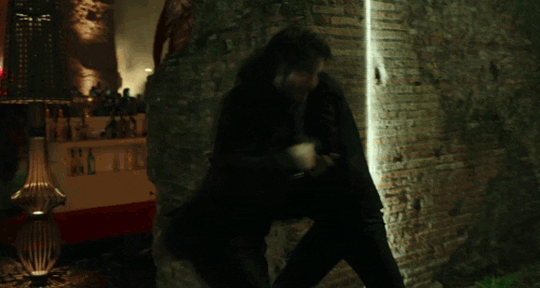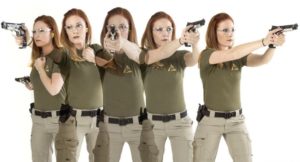Everything You’ve Learned About Stance is Wrong!
Rick Molina
March 20, 2023 | 0 CommentsI understand how the title might sound a bit arrogant. After all, I don't know you, what kind of stance you use or why, or how well you apply your stance. The point of this article is to explain why none of that matters.
It's not that any particular stance is right or wrong. Or how you're executing your stance is right or wrong. It's that any notion of "stance", in armed combatives, is wrong.
The concept of stance is about as relevant to combative shooting as it is to playing tennis. In tennis, we get into an ideal stance when we're first learning to swing a racket. Not long after that, we learn to step into an ideal stance as a machine sends a ball to the exact same, perfectly placed, spot for us to hit it.

From that point on, a big part of progressing as a tennis player is about learning how to make good hits on the ball from less than ideal positions, and sending the ball to where your opponent will be out of position when he gets to it. This goes on until, at the highest levels, world-class players are almost constantly moving and making spectacular shots from anything but an ideal stance.
So stances are used initially to help us isolate and focus on a subset of fundamental skills. After which, they're largely left behind as little more than postures we transition through as we move.
This is obvious in a game like tennis. No one would ever think standing mid-court in a stance could ever win a match. But when training to carry a gun, many of us mistakenly equate self-protection solely to shooting. And that's where things start to go off track.
Where did we go wrong
Stance is a tool for target shooters, where accuracy is the only objective. Accuracy comes from consistency. One of the ways target shooters achieve consistency is to eliminate movement. So they anchor their feet to the ground, settle into a solid stance, tuck their hand in their pocket (or grab their junk apparently) and squeeze off rounds.

Even modern "defensive handgun" stances like the Weaver and the Isosceles were born out of some version of "target" shooting. Jack Weaver developed his "stance" for Leather Slap competitions where contestants tried to hit an 8-inch balloon at 8 yards. Brian Enos and Rob Leatham developed the Isosceles for shooting in I.P.S.C. and Steel Challenge competitions where 5 to 25 targets are spread out in front of them.
None of these stances were created in the crucible of combat. They weren't conceived to handle attackers who are lunging at you with a knife, grabbing at you or your gun or shooting at you.
One of the first things you need to understand is that marksmanship shooting and combatives shooting are two completely different things. Combatives shooting isn't just faster marksmanship shooting at different targets. It's a different kind of aiming, a different kind of sight picture, a different kind of trigger pull, etc.

The second thing you need to understand is that shooting is only one small part of armed combatives. And if you ignore the other parts, your shooting skills may not be enough.
Too many who carry a gun for protection confuse shooting with combatives. Shooting is just one part of combatives.
Counter-Offensive Pressure
I've already suggested that dynamic movement, not static stance, is what we need for combatives. But why?
For two reasons.
First, remember Combatives Safety Rule #4 says you must be aware of your surroundings - where friendlies and bystanders are, where other threats might come from, the location of barriers, obstacles, cover, escape routes, etc.
You may need to move in order to respond quickly, safely and effectively.
Second, there's no room for "defense" when it comes to self-defense. That's why we prefer to use words like "combatives" and "counter-offense".
"The best defense is a good offense."
Contrary to popular belief, this is not a quote from a football coach. It's a combative strategy that's been around since 2700BC.

It's been a cornerstone principle for combatants ranging from ancient Japanese swordsmen and Chinese Warrior Monks to modern-day generals commanding the armies of today's nuclear superpowers.
The principle is simple enough. If your reaction to an attack is purely defensive it is inevitable that you will be defeated.
Ancient Gung Fu texts say it much more eloquently. "The hand that defends must also strike."
With a defensive mindset, you are relinquishing the role of predator to your attacker and relegating yourself to the role of prey. Your focus is on blocking, slipping or distancing yourself from his attacks, which he remains free to initiate, whenever and however he wants.
Taking on a counter-offensive mindset forces him, at least partially, into the prey role and advances you to prey turned predator.
Isn't that what we're doing with the gun?
Well, sorta.
Remember what we said earlier. Shooting is only one part of combatives, just as swinging a racket is only one part of playing tennis. There's tossing the ball for a serve, and not having a foot-fault, there's getting to the ball before it bounces twice, and hitting it back so it clears the net and stays in bounds. And all that comes before you ever consider where to hit the ball based on your opponent's position or movement, what kind of spin to put on the ball, or how to give yourself time to get repositioned after you return it.
Similarly, shooting just a part of what you do from the moment you realize you're under attack to the point where you've suppressed or eliminated the threat.
We can breakdown "what you do" into 3 phases.
- What you do without a gun until you get to your gun.
- What you do with your gun until you get to a shot.
- What you do while shooting until you get control.
To give yourself the highest likelihood of winning, all three phases must subject your attacker(s) to Counter-Offensive Pressure (COP). And that requires movement.
I'm not talking about complex fighting systems or elaborate martial arts sequences. Let's leave that for John Wick.

In fact, simplicity is critical.
It may just be a step to shift your weight, a tuck of your chin, a bend of your elbow, a lean, a shrug of your shoulder, a check from your offhand or a pivot of your hips that will allow you to guard your gun, clear your draw, line up your counter, and suppress your attacker without posing a threat to yourself or anyone else.
We're talking about movements that are triggered by instinct rather than decision. The basic principles of applying Counter-Offensive Pressure can be learned over a long weekend with a good instructor, not years in a dojo.
This article isn't about particular COP techniques. It's about helping you understand that stance is widely misunderstood by many who choose to carry a gun for protection, and to possibly get you thinking a little differently about how you may want to practice to be more effective with a combative handgun.
A clarification
I've tried to go into enough detail here to help you understand the reasoning behind this concept of Counter-Offensive Pressure and to give you enough data to support that reasoning behind it. In the process, I fear this written format may have made it sound much more complicated than it actually is.
In a live training environment, it only takes a few minutes to demonstrate COP in a way that makes the benefits obvious. After that we go through a few examples that give you some drills you can take home and practice on your own.
I'll try to make some time to shoot a video at an upcoming training event and insert it here. Until then, feel free to reach out to me with any questions.
We aren't tossing out everything we know about stance
What we've called stances are really just temporary postures we may pass through momentarily in our overall effort to suppress or eliminate a threat. (If you're familiar with the tennis parlance, think ground-stroke, volley, backhand, lob, smash, etc.)

Those postures are still important to understand. They become baselines we can reference as we navigate through our counter-offensive.
So it shouldn't be a discussion about whether or not we should use Isosceles OR Weaver OR Central Axis Relock OR retention. It should be about when we should use Isosceles AND Weaver AND Central Axis Relock AND retention AND any other posture that comes up along the way.
There are virtually limitless postures we could find ourselves in or moving through. The more baseline postures we familiarize ourselves with, the more fun and interesting our practices will be, and more the effective our combative skills will become.
Let's wrap it up
That tennis player jumping through the air, angling for a backhand, while she's already preparing to move back to center court as soon as her feet hit the ground, is able to do that intuitively- not because she's practiced returning that exact hit from an opponent hundreds of times. But, because she's practiced returning hundreds of different kinds of hits, which are informing her reactions to that unique situation.
That's what makes tennis fun. And that's what makes combative shooting fun.
There's a whole world of training experiences you can enjoy that go beyond standing at a indoor range like a race horse in a starting gate.
The people who are most prepared to protect themselves and their loved-ones are those who genuinely enjoy getting out and practicing. So get yourself out of the marksmanship stance mindset and start working on the real combative skills of: movement, posture and pressure. It'll be fun!
 Rick Molina
Rick Molina
